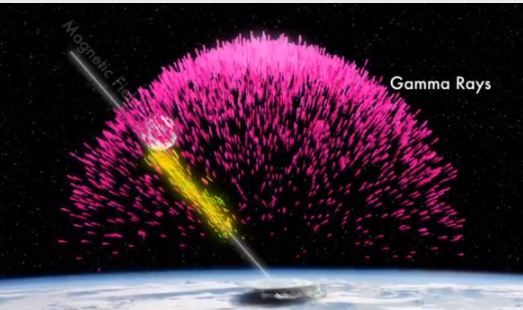

| Visitors Now: | |
| Total Visits: | |
| Total Stories: |

| Story Views | |
| Now: | |
| Last Hour: | |
| Last 24 Hours: | |
| Total: | |
Fermi’s Finds Radio Bursts From Terrestrial Gamma-ray Flashes
Lightning in the clouds is directly linked to events that produce some of the highest-energy light naturally made on Earth: terrestrial gamma-ray flashes (TGFs). An instrument aboard NASA’s Fermi Gamma-ray Space Telescope was recently fine-tuned to better catch TGFs, and this allowed scientists to discover that TGFs emit radio waves, too.
Last year, scientists using NASA’s Fermi Gamma-ray Space Telescope have detected beams of antimatter produced above thunderstorms on Earth, a phenomenon never seen before.
Scientists think the antimatter particles were formed inside thunderstorms in a terrestrial gamma-ray flash (TGF) associated with lightning. It is estimated that about 500 TGFs occur daily worldwide, but most go undetected.
Fermi is designed to monitor gamma rays, the highest energy form of light. When antimatter striking Fermi collides with a particle of normal matter, both particles immediately are annihilated and transformed into gamma rays. The GBM has detected gamma rays with energies of 511,000 electron volts, a signal indicating an electron has met its antimatter counterpart, a positron.

The outbursts, known as terrestrial gamma-ray flashes (TGFs), last only a few thousandths of a second, but their gamma rays rank among the highest-energy light that naturally occurs on Earth. The enhanced GBM discovery rate helped scientists show most TGFs also generate a strong burst of radio waves, a finding that will change how scientists study this poorly understood phenomenon.
Before being upgraded, the GBM could capture only TGFs that were bright enough to trigger the instrument’s on-board system, which meant many weaker events were missed.
“In mid-2010, we began testing a mode where the GBM directly downloads full-resolution gamma-ray data even when there is no on-board trigger, and this allowed us to locate many faint TGFs we had been missing,” said lead researcher Valerie Connaughton, a member of the GBM team at the University of Alabama in Huntsville (UAH). She presented the findings Wednesday in an invited talk at the American Geophysical Union meeting in San Francisco. A paper detailing the results is accepted for publication in the Journal of Geophysical Research: Space Physics.
The results were so spectacular that on Nov. 26 the team uploaded new flight software to operate the GBM in this mode continuously, rather than in selected parts of Fermi’s orbit.
Connaughton’s team gathered GBM data for 601 TGFs from August 2008 to August 2011, with most of the events, 409 in all, discovered through the new techniques. The scientists then compared the gamma-ray data to radio emissions over the same period.
Lightning emits a broad range of very low frequency (VLF) radio waves, often heard as pop-and-crackle static when listening to AM radio. The World Wide Lightning Location Network (WWLLN), a research collaboration operated by the University of Washington in Seattle, routinely detects these radio signals and uses them to pinpoint the location of lightning discharges anywhere on the globe to within about 12 miles (20 km).
Scientists have known for a long time TGFs were linked to strong VLF bursts, but they interpreted these signals as originating from lightning strokes somehow associated with the gamma-ray emission.
“Instead, we’ve found when a strong radio burst occurs almost simultaneously with a TGF, the radio emission is coming from the TGF itself,” said co-author Michael Briggs, a member of the GBM team.
The researchers identified much weaker radio bursts that occur up to several thousandths of a second before or after a TGF. They interpret these signals as intracloud lightning strokes related to, but not created by, the gamma-ray flash.
Scientists suspect TGFs arise from the strong electric fields near the tops of thunderstorms. Under certain conditions, the field becomes strong enough that it drives a high-speed upward avalanche of electrons, which give off gamma rays when they are deflected by air molecules.
“What’s new here is that the same electron avalanche likely responsible for the gamma-ray emission also produces the VLF radio bursts, and this gives us a new window into understanding this phenomenon,” said Joseph Dwyer, a physics professor at the Florida Institute of Technology in Melbourne, Fla., and a member of the study team.
Because the WWLLN radio positions are far more precise than those based on Fermi’s orbit, scientists will develop a much clearer picture of where TGFs occur and perhaps which types of thunderstorms tend to produce them.
The GBM scientists predict the new operating mode and analysis techniques will allow them to catch about 850 TGFs each year. While this is a great improvement, it remains a small fraction of the roughly 1,100 TGFs that fire up each day somewhere on Earth, according to the team’s latest estimates.
Likewise, TGFs detectable by the GBM represent just a small fraction of intracloud lightning, with about 2,000 cloud-to-cloud lightning strokes for every TGF.
The Fermi Gamma-ray Space Telescope is an astrophysics and particle physics partnership and is managed by NASA’s Goddard Space Flight Center in Greenbelt, Md. Fermi was developed in collaboration with the U.S. Department of Energy, with important contributions from academic institutions and partners in France, Germany, Italy, Japan, Sweden and the United States.
The GBM Instrument Operations Center is located at the National Space Science Technology Center in Huntsville, Ala. The GBM team includes a collaboration of scientists from UAH, NASA’s Marshall Space Flight Center in Huntsville, the Max Planck Institute for Extraterrestrial Physics in Germany and other institutions.



